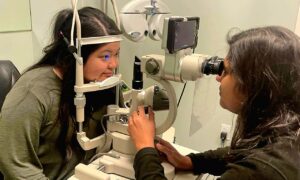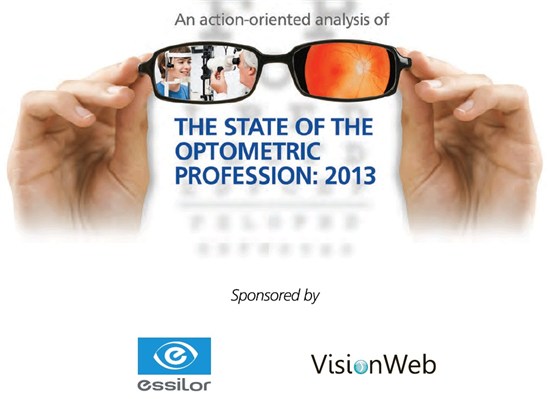
March 25, 2015
The following content highlight from The State of the Optometric Profession analyzes the supply of eyecare across varied segments of American society—and provides strategies for growing an optometric practice.
>>Click HERE or the image on the right to download the report>>
>>Click HERE for an AOA Workforce Study video featuring former AOA President Randy Brooks>>
The AOA published a major workforce study in June 2014. The estimates and projections of practicing eyecare professionals in this section are derived from the AOA Workforce Study and other industry sources including professional associations, manufacturers and publishers. The broad conclusions reached in the current assessment of provider supply are likely to be similar to the workforce study. However, the AOA study will address more issues of supply and demand and market conditions.
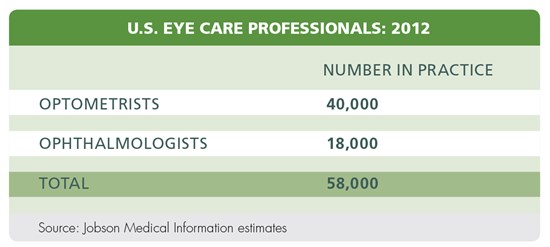
The current supply of practicing eyecare professionals is fully adequate to satisfy Americans’ demand for vision care. During 2012, there were 58,000 eyecare professionals licensed to perform comprehensive eye exams and in practice in the US, including approximately 40,000 ODs and 18,000 ophthalmologists. They serve a vision correction population totaling 202 million, as well as millions of other patients requiring therapeutic and surgical services. There is currently one licensed eyecare professional for every 3,500 people using vision correction. Inasmuch as people requiring correction account for the vast majority of eye doctor visits, and visit eye doctors infrequently, current demand for eyecare services is well satisfied by the current base of practicing professionals.
The 40,000 ODs in the US practice in many settings. Fully 57 percent have a primary practice in an independent practice owned by an OD. Another 24 percent have a primary setting as an affiliate of a retail optical chain, either as a franchisee, independent contractor or employee. A further 8 percent practice in ophthalmology offices. The remaining 11 percent of ODs practice in government and other institutional settings.
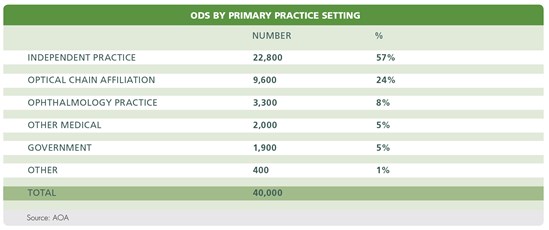
Over the long term, there has been consolidation of OD independent practices in the US. AOA surveys do not yield a precise number of OD independent practice business entities, but it is estimated that there are currently 14,000-16,000 OD businesses with no corporate or institutional affiliation. Economics favor continuing consolidation. ODs in independent practices with two or more ODs earn higher net income than ODs operating alone. Larger practices enjoy efficiencies in staff, space and equipment utilization. They have greater buying power. Management hours can be spread across a larger revenue base. Larger practices are able to offer longer business hours – an important patient convenience.
Available information suggests that the number of practicing optometrists will grow approximately 2 percent annually through 2020 and reach 46,300 in that year. The net increase will occur as an average of approximately 1,550 ODs graduate and enter practice annually, and about 750 ODs retire. Over the same time period, the number of practicing ophthalmologists is expected to be stable. At the end of 2012, ODs accounted for 69 percent of eyecare professionals in practice; by 2020 they will account for 72 percent.

Jobson projects that the number of practicing eyecare professionals will grow 11 percent (CAGR = +1.5 percent) through 2020. Over the same period, the US vision correction population is expected to grow by just 8 percent (CAGR = +0.9 percent). These projections suggest that there will be a more than adequate supply of eyecare providers for routine vision care services in the US, although local shortages may exist. The projection suggests it is unlikely that MDs will grow more active in dispensing corrective devices, because the static number of MD hours available will be needed to satisfy the rapidly growing demand for treatment of ocular disease and refractive surgeries. Also, the flat supply of ophthalmologists creates a substantial opportunity for optometrists to expand provision of medical eyecare.
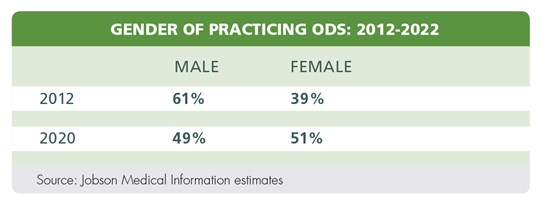
Over the next 10 years, 65 percent of new ODs entering practice will be women and 90 percent of retiring ODs will be men. This will change the gender ratio of practicing ODs, a trend that has been developing over several decades. Currently the male/female split among practicing ODs is 61/39 percent. In 2022 it is likely to be 48/52 percent.
Among OD students who will graduate in 2014, some 80 percent will enter practice with $100,000 or more of student loan debt, which will impact their career decisions. Most graduating ODs aspire to work in independent OD practices and to be self-employed, even as many recognize this is not a realistic near-term goal. Given the job opportunities likely to be available over the next decade, many more graduating ODs will be corporate affiliated than currently plan to pursue this career path.
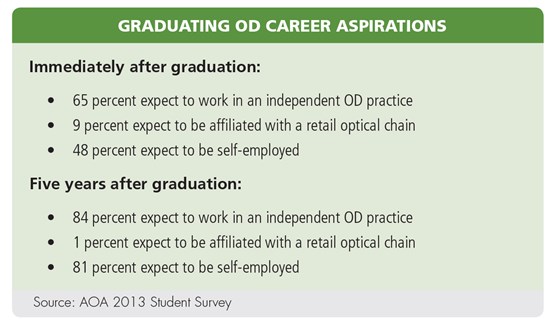
Non-OD staff members working in OD offices represent an important eyecare supply component, inasmuch as staff performs a host of clinical, dispensing and administrative duties to deliver eyecare to the population. Based on AOA surveys, it is estimated that OD independent practices currently employ 80,000 staff members. An additional 24,000 people work in corporate-affiliated OD offices, including those compensated by the optical chain hosts.
Management & Business Academy analyses reveal that among larger OD independent practices, a higher ratio of staff hours to OD hours worked exists, indicative of a higher level of delegation of routine clinical and administrative tasks. The continuing consolidation of OD independent practices is increasing the ratio of staff hours to OD hours in independent OD practices overall.
A consequence of the more-than-adequate supply of ODs in the US will be that many individual ODs will feel pressure to find new revenue sources.

Despite an increasing proportion of patients enrolled in vision and medical insurance plans offering vision benefits, there has been no increase in annual per capita utilization of OD services over the past 15 years. AOA member surveys show that the average number of comprehensive eye exams ODs perform per hour has not changed, and is just 1.1 per hour. Surveys conducted by the Management & Business Academy reveal a similar benchmark, but show that highly productive practices achieve an exam-per-OD ratio of 1.5 or more. This supports a conclusion that many ODs have the capacity to see additional patients for either vision or medical eyecare.
Actionable Strategy Imperatives
This overview of the OD supply situation identifies several priorities for ODs to respond to in a business environment with increased numbers of eyecare providers:
• Differentiate the practice value proposition. With a more-than-adequate supply of ODs to satisfy primary eyecare demand, prosperity will flow to providers who successfully differentiate their services from competitors and fill in gaps in access to medical eyecare created by lack of growth in supply of ophthalmologists. For independent ODs, a patient loyalty strategy, based on providing highly personalized care, is likely to be an effective differentiator.
• Increase hourly production. A plentiful supply of ODs will aggravate the current situation in which available OD hours are underutilized in many practices. To prosper, ODs can focus on achieving high hourly productivity through maximum delegation to staff and more disciplined patient flow management.





